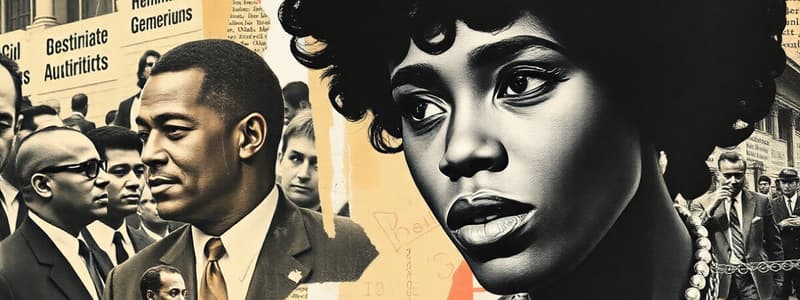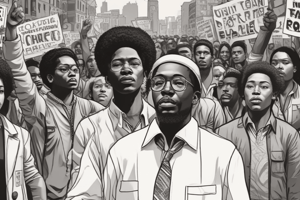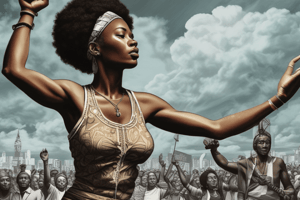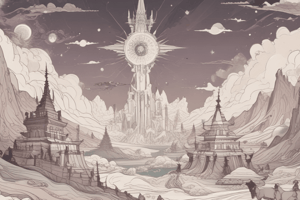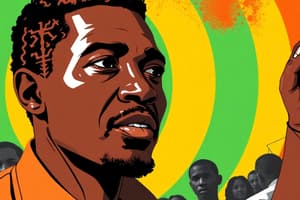Podcast
Questions and Answers
Which tactic, employed by Native Americans, aimed to draw attention to issues concerning treaties and rights?
Which tactic, employed by Native Americans, aimed to draw attention to issues concerning treaties and rights?
- Establishing tribal courts to challenge federal laws directly.
- Lobbying Congress to pass legislation protecting Native American lands and resources.
- Occupying Alcatraz Island and the 'Train of Broken Treaties' protests. (correct)
- Forming alliances with African American civil rights groups for joint demonstrations.
What legal action, passed shortly after Dr. King's assassination, aimed to combat housing discrimination?
What legal action, passed shortly after Dr. King's assassination, aimed to combat housing discrimination?
- The Civil Rights Act of 1964, focusing on employment and public accommodations.
- The Fair Labor Standards Act, addressing wage disparities across different demographics.
- The Voting Rights Act of 1965, ensuring access to the ballot for minority citizens.
- A law banning discrimination in housing sales and rentals. (correct)
What action is most closely associated with CORE and SNCC during the Civil Rights Movement?
What action is most closely associated with CORE and SNCC during the Civil Rights Movement?
- Organizing legal challenges to segregation in schools and universities.
- Establishing community centers to promote black culture and identity.
- Lobbying Congress for the passage of landmark civil rights legislation.
- Registering black voters in Mississippi. (correct)
What practice, famously undertaken in Greensboro, NC, aimed to challenge segregation through nonviolent direct action?
What practice, famously undertaken in Greensboro, NC, aimed to challenge segregation through nonviolent direct action?
What distinguishes the group of African Americans mentioned in the context that sets them apart from other civil rights groups?
What distinguishes the group of African Americans mentioned in the context that sets them apart from other civil rights groups?
What theme did the book by Betty Friedan explore, contributing to the rise of second-wave feminism?
What theme did the book by Betty Friedan explore, contributing to the rise of second-wave feminism?
What was the primary focus of the rally held in Washington, D.C., where Dr. King delivered his 'I Have a Dream' speech?
What was the primary focus of the rally held in Washington, D.C., where Dr. King delivered his 'I Have a Dream' speech?
What action is Rosa Parks best known for, and what broader movement did it catalyze?
What action is Rosa Parks best known for, and what broader movement did it catalyze?
What event prompted President Kennedy to send federal troops to escort James Meredith to class?
What event prompted President Kennedy to send federal troops to escort James Meredith to class?
What characterized the uprising of African Americans in Los Angeles?
What characterized the uprising of African Americans in Los Angeles?
Flashcards
Malcolm X
Malcolm X
Advocate of Black nationalism, member of the Nation of Islam (1952-1964), assassinated in 1965.
Gay Rights Movement
Gay Rights Movement
The beginning of the gay rights movement started when the NY police raided a gay bar.
The Feminine Mystique
The Feminine Mystique
Book by Betty Friedan describing women who led fulfilling lives but were ultimately discontent.
Affirmative Action
Affirmative Action
Signup and view all the flashcards
NOW (National Organization for Women)
NOW (National Organization for Women)
Signup and view all the flashcards
Accessibility Law
Accessibility Law
Signup and view all the flashcards
Fair Housing Act
Fair Housing Act
Signup and view all the flashcards
Cesar Chavez
Cesar Chavez
Signup and view all the flashcards
Afrocentrism
Afrocentrism
Signup and view all the flashcards
Sit-ins
Sit-ins
Signup and view all the flashcards
Study Notes
- Study guide covering chapters 44-46, focusing on the Civil Rights Revolution from 1955-1965 ("Like a Mighty Stream"), the shift from Black Power to Affirmative Action between 1965-1980, and the Widening Struggle from 1960-1990
- Advocate of Black nationalism and member of the Nation of Islam from 1952 to 1964 was assassinated in 1965
- African American students were escorted to Central High School classes by federal troops under President Eisenhower's orders
- The gay rights movement began when NY police raided a gay bar, as homosexuality was outlawed in NY, patrons fought back
- Betty Friedan's book described women who led "fulfilling lives" but were ultimately discontent
- CORE and SNCC worked to register black voters in Mississippi
- A government program encouraged employers to increase minority and women employment
- A group was founded in 1966 to advance women's rights, primarily composed of middle-aged, middle-class women
- A group of African Americans worked toward self-determination, provided community services, carried firearms, and was willing to challenge the police
- Civil rights activists, led by Dr. King, practiced nonviolent resistance
- Native Americans occupied Alcatraz Island, declared a "National Day of Mourning" on Thanksgiving Day, and organized the Train of Broken Treaties to highlight Native American issues
- Students trained in civil disobedience and direct action collaborated with the SCLC, abandoned nonviolence, and purged white members
- Holiday from December 26 to January 1 celebrates African American culture, including faith, creativity, and unity
- Law called for better public access for people with disabilities (accessibility, braille signage, and better transportation)
- Law banned housing sales and rentals discrimination shortly after Dr. King's assassination
- Law banned discrimination based on race, sex, religion, or national origin
- Law required federal government to supervise voter registration, especially in the South
- The leader of the United Farm Workers (UFW) used long-term strikes and hunger strikes for farm worker rights
- Movement emphasized African history, culture, and achievements of African peoples and their descendants in the U.S.
- New movement away from nonviolent civil disobedience to action, popularized by Stokely Carmichael, new leader of SNCC by 1966
- Greensboro, NC was the site of the nonviolent practice of occupying seats at lunch counters to force integration
- Dr. King's open letter from jail explained African Americans' use of civil disobedience and direct action to protest segregation, including the line, "justice too long delayed is justice denied"
- Students, both black and white, rode desegregated buses through the South to push for desegregation; riders were attacked by Southerners
- A rally in DC focused of inequality in America for civil rights and jobs; Dr. King's famous speech, "I have a dream"
- Asian Americans, while assimilating, brought college campus attention to the Asian American experience
- Rosa Parks' refusal to give up her seat in Montgomery, Alabama sparked a bus boycott lasting over a year, leading to the reversal of segregated seating policies
- Supreme Court upheld busing as a means to address de facto segregation
- University of Mississippi was ordered by President Kennedy to desegregate and allow James Meredith to enroll, federal marshals escorted him to campus and classes, and he graduated in 1963
- African Americans in Los Angeles revolted against poverty, prejudice, and police mistreatment, resulting in extensive property damage
Studying That Suits You
Use AI to generate personalized quizzes and flashcards to suit your learning preferences.
